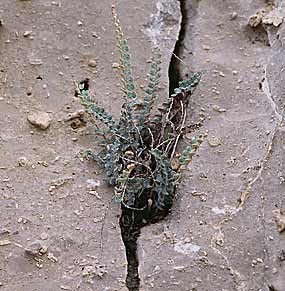
NPS Photo - Cookie Ballou Although usually associated with moist tropical regions, ferns are found in almost every imaginable habitat in the world's temperate zones, including deserts. Perennial ferns are often found growing in moisture-retaining crevices, a viable adaptation for survival in the desert. They remain dormant throughout most of the year, simply awaiting infrequent rains to grow and reproduce. Desert ferns possess excellent drought-resistant features, including hardened and thickened tissues, a waxy layer covering leaf surfaces, highly dissected leaves, leaves that curl into compact balls, and leaf and stem surface hairs. These features help to disperse heat, reduce evaporation, and retard the destructive effects of hot winds. Typically, ferns are composed of an underground stem (rhizome) with roots and a number of compound green leaves (fronds) that extend well above ground. They lack flowers or seeds. In season, clusters of tiny capsules containing numerous ripening spores develop on the undersides of the leaflets. Eventually the capsules snap open, catapulting millions of minute spores into the breeze. These may remain viable for years. Ferns may also reproduce by means of creeping rootstocks. |
Last updated: February 24, 2015
